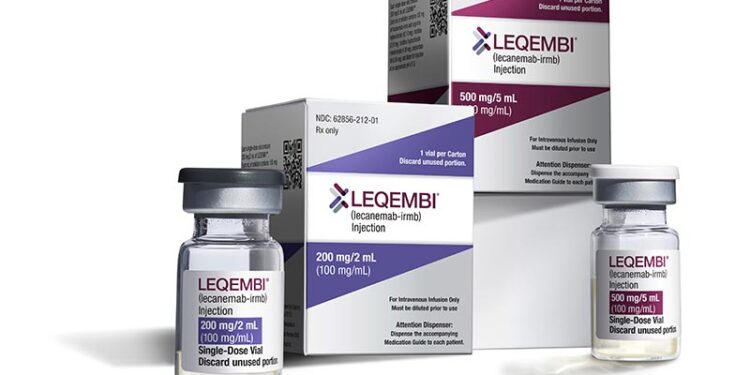Approved by the EU Commission in April, the Alzheimer’s drug Leqembi has now also been approved in Germany and Austria. It is a new antibody (active ingredient: lecanemab) that was developed for the treatment of early-stage Alzheimer’s disease – in particular mild cognitive impairment (MCI) or incipient Alzheimer’s dementia.
This makes Austria and Germany one of the first in the EU; Leqembi is approved in 48 countries worldwide as of September 1, 2025.
We have summarized the most important information about this medicine:
- How does the medicine work?
In Alzheimer’s disease, the nerve cells in the brain gradually die off, leading to a loss of mental capacity. Although the causes are not yet fully understood, research assumes that toxic deposits in the brain are responsible. You will probably hear more about these two protein deposits in the future: The clumps in question are called amyloid beta and tau fibrils. Many clumps and deposits of these substances accumulate in the brains of affected patients. Initially, the hippocampus region of the brain, which is responsible for memory, is particularly affected. Therefore, a typical early symptom is a problem with short-term memory, further challenges in planning and organizing, mood and behaviour change.It is assumed that these clumps disrupt communication between the cells and the supply of nutrients. As a result, the nerve cells die and those affected suffer degeneration. The drug Leqembi recognizes the precursors of these clumps and deposits and binds them. This activates the patient’s own immune system, breaking down the clumps and preventing new plaques from forming.
- Can Alzheimer’s now be cured?
No – a cure is not possible. Leqembi aims to slow down mental decline in those affected at an early stage, but cannot stop it. One study showed that mental decline was slowed by an average of 31% after 18 months. 31% on average after 18 months.Although Leqembi has been proven to be effective, experts rate the overall benefit as rather limited. It remains unclear how noticeable the slowing of the disease actually is in the everyday lives of those affected. However, the data to date suggests that the effect increases with longer treatment duration. Further studies will have to clarify whether therapy beyond the 18 months investigated so far will bring even greater benefits.
- Who is suitable for Leqembi?
Unfortunately, the drug is only suitable for a small proportion of Alzheimer’s patients:
- The medication is only suitable for patients in the early stages of the disease, i.e. those diagnosed with Alzheimer’s in the mild cognitive impairment stage or in the early stages of Alzheimer’s dementia.
- The deposits discussed above need to be detected (e.g. by lumbar puncture or amyloid PET (positron emission tomography). This is a special imaging procedure that is used to visualize deposits of amyloid beta in the brain.
- Those affected may only carry one copy of the ApoE4 gene; people with two copies are excluded due to the higher risk of side effects. The risk of side effects such as brain swelling or cerebral hemorrhage is significantly increased.
Risk genes play a role in determining whether there is a higher or lower risk of developing Alzheimer’s disease. The best known and most important gene is the protein ApoE4, which can be passed on from both parents to their children. 60% of all Alzheimer’s sufferers carry at least one copy of ApoE4. About 25% of the population carry one copy, about 2% carry two copies of this gene. People with two copies of this gene have the highest risk of developing Alzheimer’s disease (about 10 times higher than people with other ApoE variants).
The tests for ApoE4 have so far only played a role in research studies, but in future they will be part of the standard diagnostics for treatment in the early stages of the disease.
- It is not permitted to take anticoagulants at the same time, as this combination significantly increases the risk of cerebral hemorrhage.
- How many patients are potentially treatable?
According to an estimate by the German Institute for Quality and Efficiency in Healthcare from May 2025, around 1 in 100 people with Alzheimer’s dementia meet the requirements for treatment with the drug. New calculations by the Central Institute of Statutory Health Insurance Physicians in Germany put the figure at around 6% of sufferers. However, this figure is regarded as an optimistic upper limit. A significantly lower figure is assumed due to complex diagnostics, several exclusion criteria (e.g. early diagnosis, see above for details) and limited medical capacities with the necessary personnel and technical equipment.This is because the treatment should be initiated and monitored by doctors who “have experience in the diagnosis and treatment of Alzheimer’s disease and the ability to perform a magnetic resonance imaging (MRI) scan in a timely manner.” Infusions should also be administered “by qualified healthcare professionals who are trained in monitoring for, recognizing and treating infusion-related reactions.” In practice, the treatments are therefore not administered by GPs, but by outpatient memory clinics, for example. In Austria, the Vienna General Hospital is already carrying out the first treatments.
- How does treatment work?
Leqembi is administered every two weeks via an infusion (duration: approx. 1 hour). Special MRI checks are necessary before and during treatment in order to detect possible side effects (brain swelling or bleeding) at an early stage. Treatment is discontinued if the Alzheimer’s disease worsens and progresses to a moderate stage. This is checked every 6 months.Participation in an EU-wide monitoring program is mandatory, and both the patients and the treating physicians are entered in a central register.
- What side effects are known?
Some of the participants experienced brain swelling and bleeding. These were often asymptomatic, but were of course closely monitored. Other side effects: Infusion reactions, headaches.Three deaths occurred in the study, two of which were associated with the simultaneous use of anticoagulants – according to the manufacturers, without a proven causal link to the drug itself
- Why is Leqembi important?
For the first time in Alzheimer’s therapy, there is a drug that directly targets the basic, disease-causing mechanism – i.e. the amyloid deposits. Until now, the main focus has been on alleviating the symptoms (e.g. anti-dementia drugs to improve signal transmission and neuroleptics to alleviate certain accompanying symptoms such as outbursts of anger, hallucinations and delusions). - Will there be more drugs on the market?
The drug Kisunla (donanemab) is currently undergoing the approval process in the EU; as of September 1, 2025, it has already been approved in the USA, Japan, China and the UK. In July 2025, the Expert Council of the European Medicines Agency (EMA) recommended approval, and experts expect approval in a few months.Kisunla is being developed by Eli Lilly and also aims to trigger an immune response to remove the toxic protein deposits in the brain. As with Lequembi, this drug can only slow down cognitive decline, but not prevent it altogether.
Would you like to find out more about the medication from reliable sources? Then we recommend:
In German:
- More about Leqembi
- More about the Causes of Alzheimer’s
- Medication for Alzheimer’s disease
- More about the Risk gene ApoE4
- More about the Drug Kisunla
In English:
- European Medicines Agency: Overview of Leqembi
The FDA (US Food & Drug Administration) recommends additional, earlier MRI monitoring for Alzheimer’s patients taking Leqembi
Author: Anja Herberth
Chefredakteurin
















